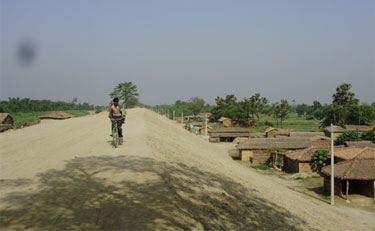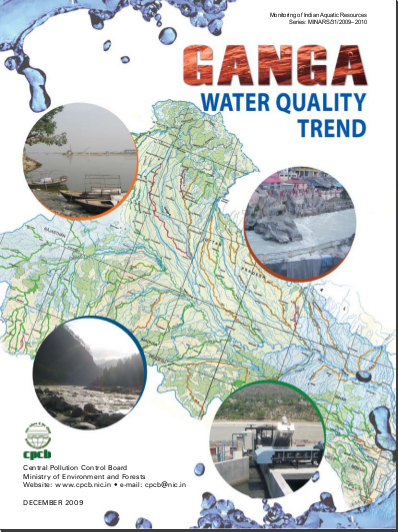Bihar
Union Cabinet approves amendment to Damodar Valley Corporation Act, 1948 in 2011
Posted on 17 Jun, 2011 04:03 PMThis approval is for the reconstitution of the Damodar Valley Corporation with four full time members, namely, Chairman, Member (Technical), Member (Finance) and Member Secretary; and six part time members, namely – one representative from the Central Government; two representatives – one each from the Government of Jharkhand and the Government of West Bengal; three independent experts- one each from the field of irrigation, water supply and generation or transmission of electricity. The Chairman will be the Chief Executive Officer of the Corporation. The posts of Financial Adviser and Secretary will be abolished.
Villages in north Bihar sinking in Bagmati's sand - Entire flood control planning needs thorough review - Article by Dinesh Kumar Mishra in d-sector.org
Posted on 16 Jun, 2011 03:56 PM The Bagmati Embankment separating riverside on the left and countryside of the right near Ibrahimpur – Electric poles suggest the height of the embankment
The Bagmati Embankment separating riverside on the left and countryside of the right near Ibrahimpur – Electric poles suggest the height of the embankment
One often hears about the civilizations buried under earth and attributes various reasons for such disappearance of life from a particular place. Excavations reveal the way of life the people might have had before they chose to leave their villages and towns and allowed the nature to take its own course. These accounts are available in books and we all believe the process told to us by historians and archaeologists. These are all conjectures that are revealed by scientific investigations but how many of us have seen, not read, how the civilizations get buried under the debris created by nature? There are places in Bihar where one can see the process of disappearance of civilization and the villages getting buried under the sediments brought by rivers.
Accessing safe drinking water during floods in North Bihar
Posted on 13 Jun, 2011 03:23 PMThis season in the region is commonly referred to as – Barh (flood). For centuries local people have treated it as ‘a way of life’, and found ways to deal with it. Post independence, this ‘way of life’ gradually transformed into an assured annual devastation. The once self-sufficient communities in the flood plains have been relegated to being highly dependent on sources external to the village for their survival during floods.
Guidelines for extending green revolution to eastern India - Document prepared by Department for Agriculture and Cooperation (2011)
Posted on 27 May, 2011 07:50 AM The states of Assam, Bihar, eastern U.P, Chattisgarh, Jharkhand, Bengal, Orissa were allocated extra funds in the last year for this purpose.
The states of Assam, Bihar, eastern U.P, Chattisgarh, Jharkhand, Bengal, Orissa were allocated extra funds in the last year for this purpose.
"Media getting sensitive towards water and sanitation issues in North Bihar"-Recent updates from the work of Megh Pyne Abhiyan
Posted on 10 May, 2011 06:41 PM. I had shared how Megh Pyne Abhiyan through its local partner - Samta in Khagaria (supported by Gramyasheel, Kosi Seva Sadan, Ghoghardiha Prakhand Swarajya Vikas Sangh and Water Action) has been able to collaborate with the district administration to mainstream issues concerning water and sanitation for the flood prone areas.
In Supaul, the district administration requested our local partner, Gramyasheel to write about alternative drinking water practices (appropriate for the district) for a publication - Supaul Zila Ki Smarika, brought out by the district administration. A definite indication of the WATSAN practices being recognized at the local level. Though the collaboration is an ongoing process which would lead to positive results if time, ideas and perseverance are invested appropriately.
Ganga water quality trend - A report by Central Pollution Control Board (2009)
Posted on 30 Apr, 2011 05:39 PM The data has been collected over a period of many years from 39 water quality monitoring stations along the main river and 102 stations on its tributaries which were setup in 2008/09.
The data has been collected over a period of many years from 39 water quality monitoring stations along the main river and 102 stations on its tributaries which were setup in 2008/09.
The study focuses on the parameters for dissolved oxygen, (DO), biochemical oxygen demand (BOD) and faecal coliforms (FC) as these indicate the biological health of the river. The period of study for the river Ganga is 1999-2008. The study finds that most of the water quality parameters studied do not meet the standards.
History of irrigation in Bihar – Ancient, British and upto Pre-plan Period – A report by the Water and Land Management Institute, Patna
Posted on 23 Apr, 2011 10:29 AMIrrigation is being practiced there since ancient times dating back to Kautilya, who lived in Patliputra (now Patna), which was the capital of the mighty Mauryan empire (400 BC). Kautilya had laid down the principles on rainfall and irrigation in his famous book Kautilya Arthasashtra.
The effects of agricultural water and landholdings to rural livelihoods in Indo-Gangetic basin – Research analysis by IWMI and ICAR with an emphasis on Bihar
Posted on 18 Apr, 2011 11:56 PM The current research analysis by International Water Management Institute (IWMI) in cooperation with ICAR Resear
The current research analysis by International Water Management Institute (IWMI) in cooperation with ICAR Resear
Hard work, no pay - Summer jobs off the beaten track - Opportunities for working on NREGA and ICDS schemes in Araria, Bihar
Posted on 14 Apr, 2011 04:44 PMForwarded to the portal by: Kamayani Swami and Ashish Ranjan for Jan Jagaran Shakti Sangathan
Do you support the National Rural Employment Guarantee Act (NREGA) and the Integrated Child Development Scheme (ICDS)? Then why not give some of your time to help make it work?
Evaluation of sanitation and wastewater treatment technologies: Case studies from India
Posted on 15 Nov, 2010 11:52 PMThe sanitation systems studied are spread across the country. The study goes to Pratapnagar in Bihar to evaluate the success of the septic tank to Asalthpur in Uttar Pradesh to study the Ecosan (UDDT) toilet. Other locations in India include Maharashtra, Gujarat, Kerala.